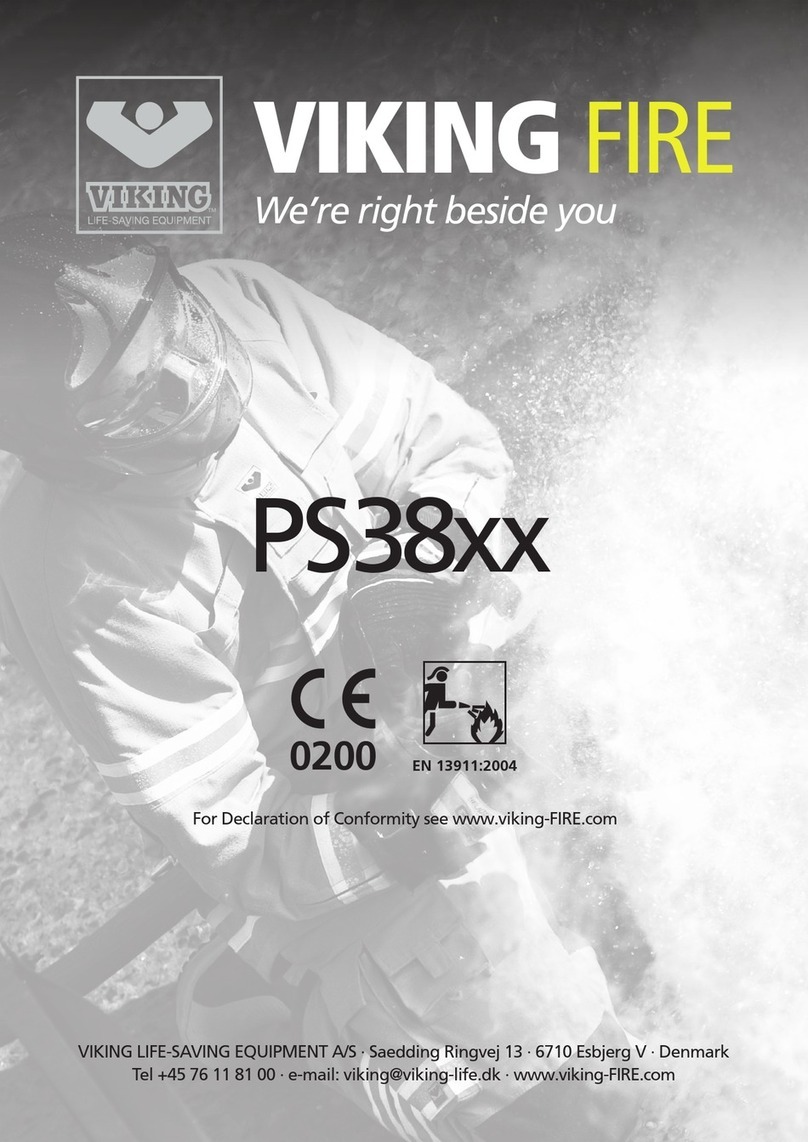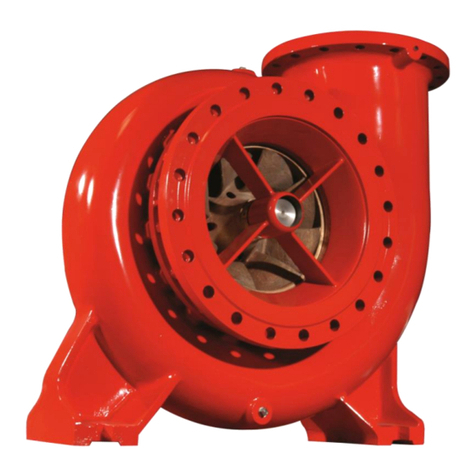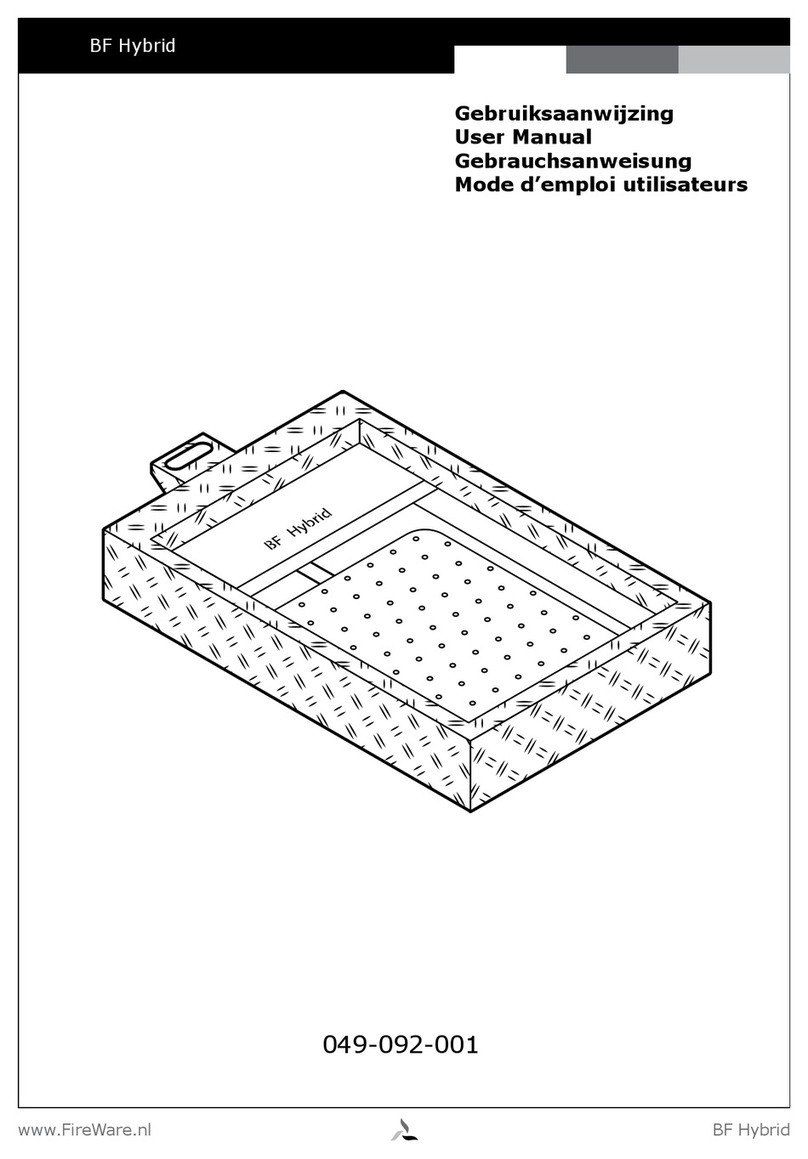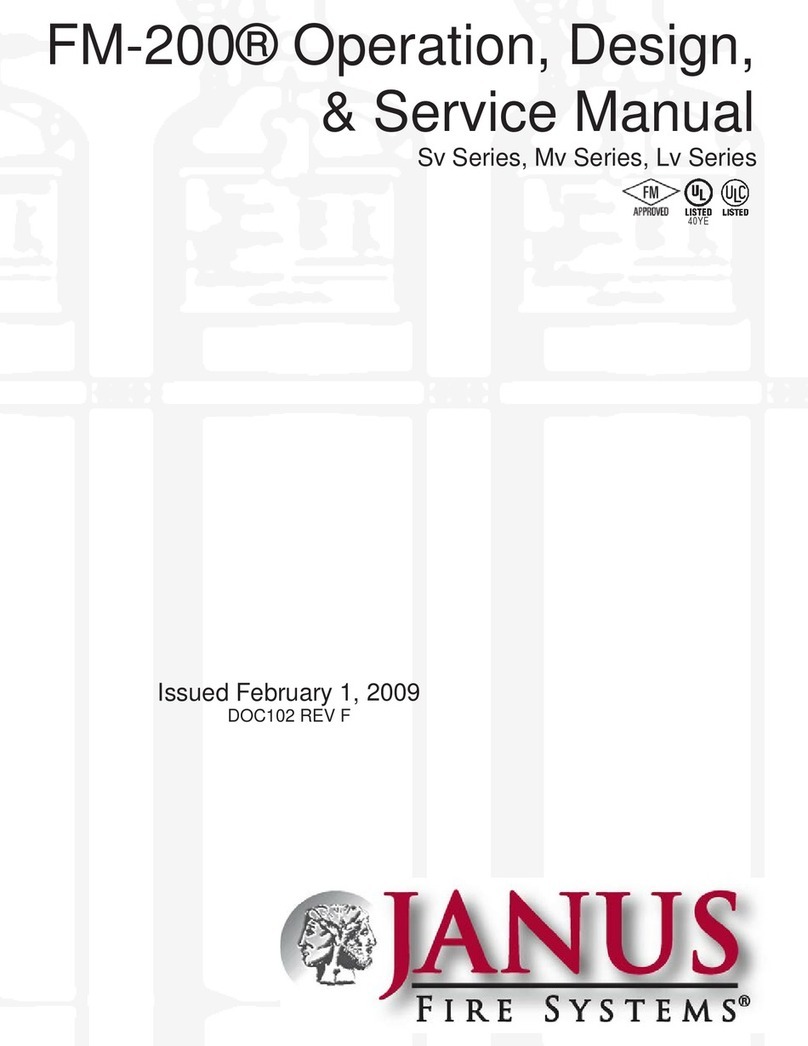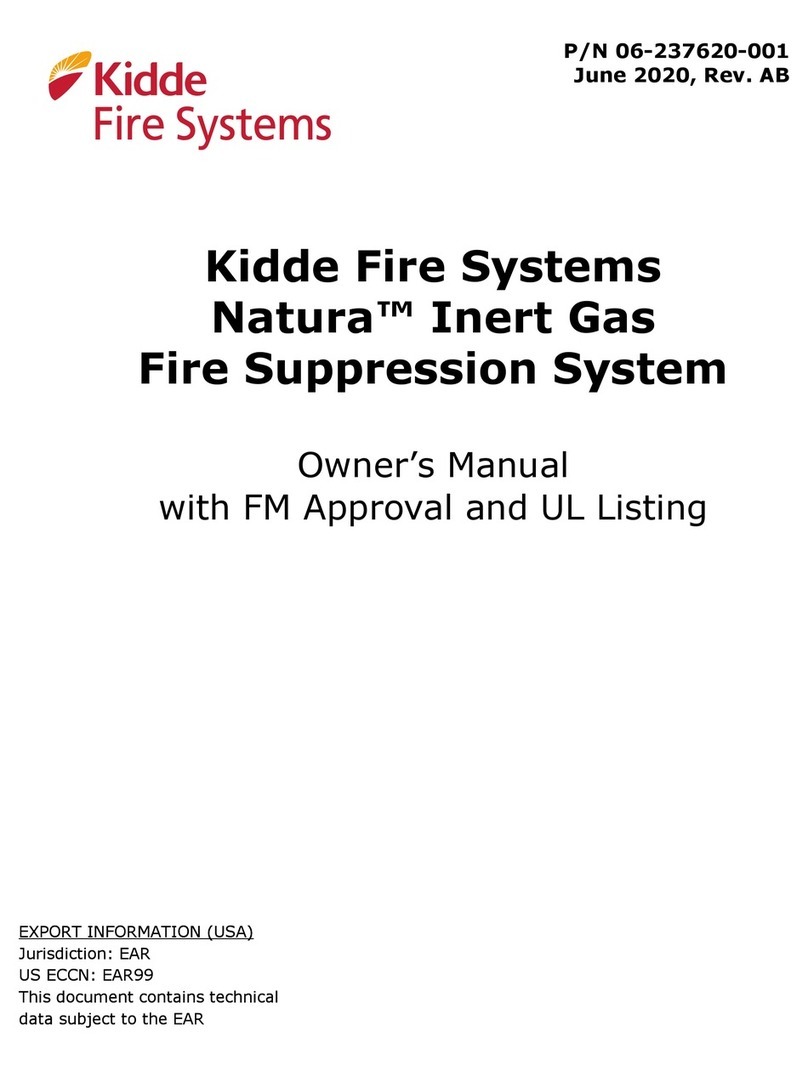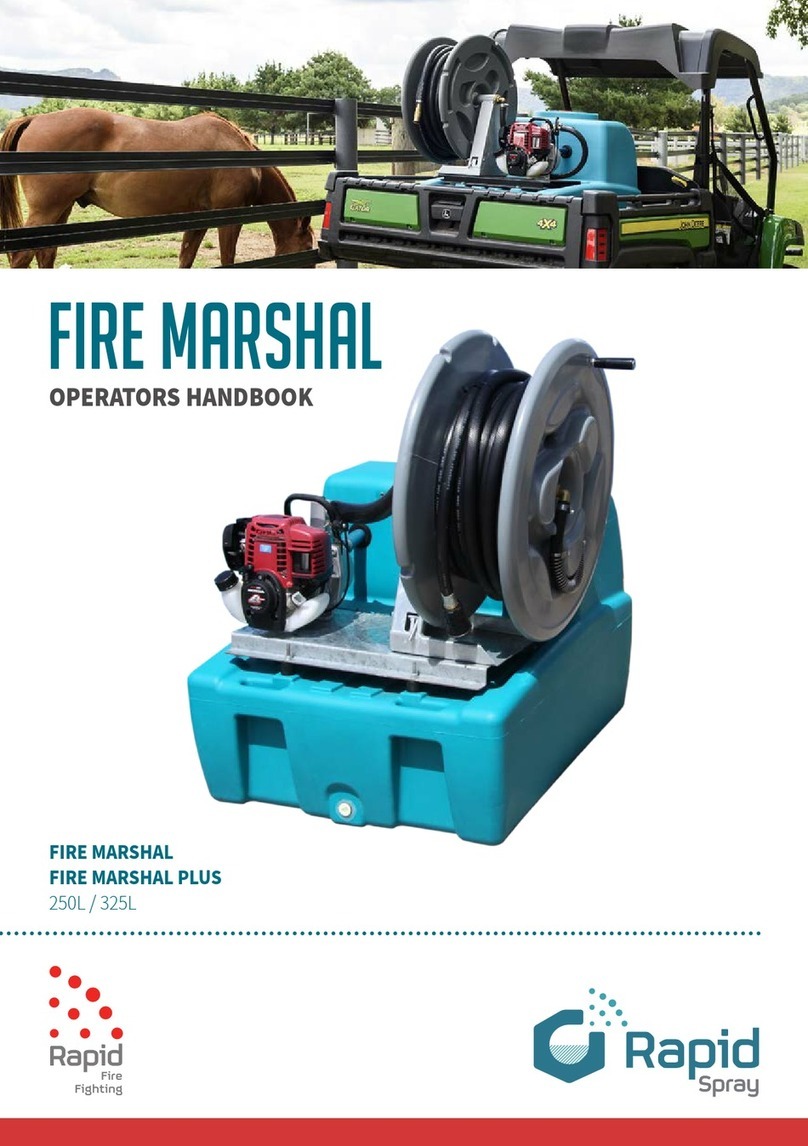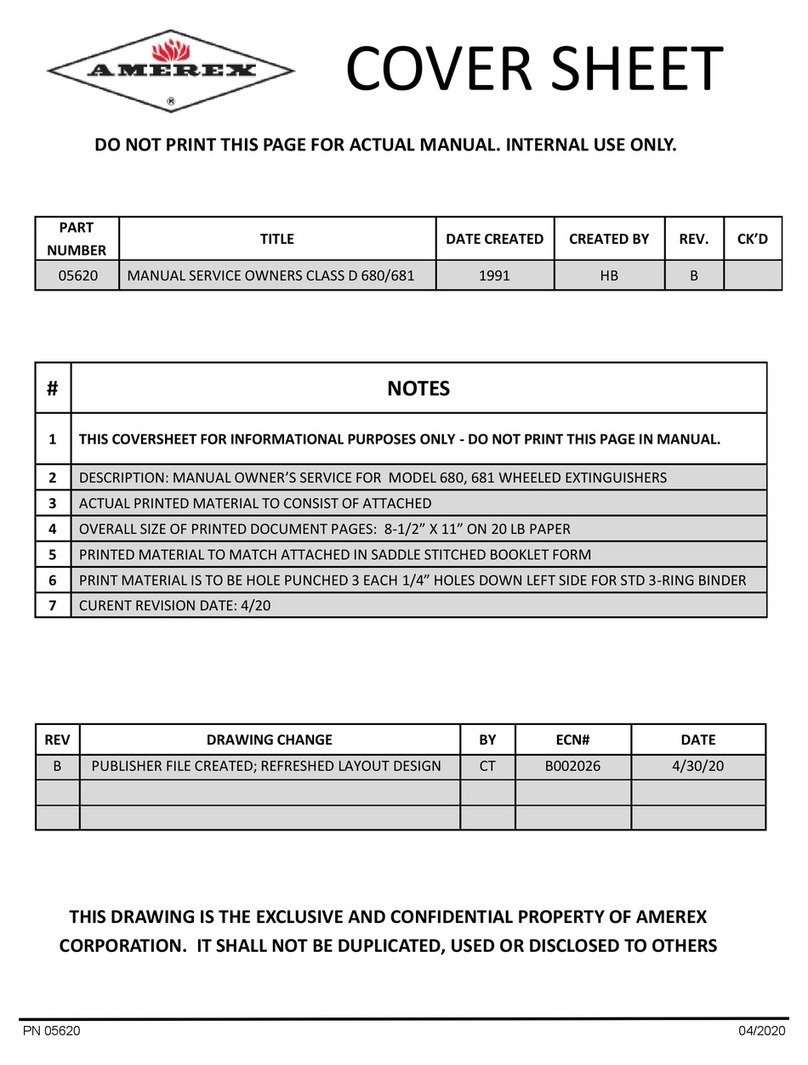Viking Oxeo PR LCP User manual

Operator’s Manual
Oxeo Inert Gas Extinguishing System

IMPORTANT! Read this document before starting any work.
This document is a mandatory part of the installation and should always be stored in a easily
accessible location and retained for future use.
This document is a translation of the original German document with modifications specific
to the usage in North and South America.
The Viking Corporation
210 N. Industrial Park Dr.
Hastings, MI 49058
USA
Phone: 269-945-9501
Fax: 269-818-1680
www.vikinggroupinc.com
Document ID: F_101821
Revision: 02
Release date: 08-15-2022

Operator’s Manual | Oxeo PR LCP | F_101821 Rev 02 | 08-2022 | en 1
Table of Contents
1 General ................................................................................... 5
1.1 Information About this Manual ............................................. 5
1.2 About This Document............................................................... 6
1.3 UL Approved Systems ............................................................... 6
1.4 Requirements For Detection Elements And Control Panels 7
1.5 Copyright ....................................................................................... 8
2 Safety....................................................................................... 9
2.1 Safety and warning notices..................................................... 9
2.2 Warnings in instructions........................................................... 10
2.3 Intended use................................................................................. 10
2.4 Safe operation.............................................................................. 12
2.5 General dangers .......................................................................... 13
2.6 Qualification of personnel ....................................................... 16
2.7 System-specific design specifications................................. 18
2.8 Personal protective equipment............................................. 18
2.9 Operator's obligations .............................................................. 19
2.10 Safety and protective devices.............................................. 21
2.11 Signage ........................................................................................ 23
2.12 Environmental protection..................................................... 27
2.13 Behavior in the case of fire.................................................... 27
3 Transport and Storage ...................................................... 29
3.1 Transport ........................................................................ 29
3.2 Storing extinguishing agent containers............................. 30
4 Design and Function ........................................................ 31
4.1 Functional description .............................................................. 31
4.2 Oxeo unistrut racking arrangements................................... 34
4.3 Manifold 200 bar and 300 bar, DN50................................... 34
4.4 Check valve KRV-2 ...................................................................... 35
4.5 Extinguishing cylinder with quick release valve QRV.... 35
4.6 Hose for extinguishing agent................................................. 41

Operator’s Manual | Oxeo PR LCP | F_101821 Rev 02 | 08-2022 | en
2
Table of Contents
4.7 Pilot hoses for activation of “slave” cylinder .................... 42
4.8 Monitored blocking................................................................... 43
4.9 Pressure reducer......................................................................... 43
4.10 Manifold safety valve.............................................................. 46
4.11 Occupiable space protection kit ........................................ 47
4.12 Shuttle non-return valve....................................................... 55
4.13 Pilot pressure relief assemblies........................................... 56
4.14 Blocking device, pilot line..................................................... 58
4.15 Downstream pipework.......................................................... 58
4.16 Limit switch, pneumatically operated.............................. 58
4.17 VN Nozzle.................................................................................... 60
4.18 DCM Nozzle................................................................................ 61
4.19 Pilot line made of precision steel pipe............................. 61
5 Installation and Commissioning.................................... 63
6 Operation............................................................................... 65
6.1 Resetting the isolation in the event of fire........................ 74
6.2 Activating the system............................................................... 74
6.3 Actions after the system is activated .................................. 78
6.4 Changing over the main/reserve change-over ............... 81
6.5 Remove the extinguishing agent container..................... 81
7 Inspections ............................................................................ 83
8 Cleaning ................................................................................. 87
8.1 Warnings regarding the cleaning of the system............. 87
8.2 Cleaning the system.................................................................. 88
9 Servicing and Repair .......................................................... 91
10 Malfunctions....................................................................... 93
10.1 Warnings regarding troubleshooting .............................. 94
10.2 Fault indicators......................................................................... 95

Operator’s Manual | Oxeo PR LCP | F_101821 Rev 02 | 08-2022 | en 3
Table of Contents
10.3 Malfunction table ..................................................................... 95
10.4 Correct the display of the contact pressure gauge...... 99
10.5 Putting the system back into operation .......................... 100
11 Inspections.......................................................................... 101
11.1 Final shutdown and disassembly ....................................... 101
11.2 Disposal........................................................................................ 102
12 Technical Data................................................................... 103
12.1 Operating conditions.............................................................. 103
12.2 Emissions..................................................................................... 104
13 Appendix A - Weekly Inspections............................... 105
14 Safety Data Sheet - IG-01 (Argon)............................... 107
15 Safety Data Sheet - IG-100 (Nitrogen)....................... 115

Operator’s Manual | Oxeo PR LCP | F_101821 Rev 02 | 08-2022 | en
4
Table of Contents

Operator’s Manual | Oxeo PR LCP | F_101821 Rev 02 | 08-2022 | en 5
1 General
1.1 Information About this Manual
This manual describes the operation of Oxeo inert gas extinguishing systems “Oxeo PR LCP”with a
pressure reducer (also referred to hereinafter as “system”). Information about fire detection and
electrical control is not part of this manual. Qualified knowledge of the extinguishing agent used
and the technical details of Oxeo inert gas extinguishing systems “Oxeo PR LCP” with a pressure
reducer are prerequisites for working with this manual.
This operating manual contains neither detailed information concerning project planning of the
system, nor detailed information concerning installation and maintenance. For this, observe the
design manual and the installation and maintenance manual, which can be obtained through
authorized dealers.
This manual is intended for the operator of the fire extinguishing system.

General
Operator’s Manual | Oxeo PR LCP | F_101821 Rev 02 | 08-2022 | en
6
1.2 About This Document
This document enables the intended use of the described system. Observing all specified
instructions and all safety instructions is the prerequisite for safe work. Furthermore, the local
accident prevention regulations and general safety conditions for the use of the system are
also described.
If this document refers directly or indirectly to laws, regulations, or directives from them, the
manufacturer cannot be held responsible for the correct, complete or up-to-date nature of
the reference.
Observe the applicable guidelines, standards, and statutory legislation of the respective coun-
try of deployment.
1.3 UL Approved Systems
In addition to this manual, the following must be taken into consideration for UL Approved
fire extinguishing systems:
•NFPA 2001 for installation, maintenance and testing requirements
•Use of clean agent system unit in accordance with the Environmental Protection Agency's
Significant New Alternatives Program (EPA's SNAP)
Monitoring of the electrical release devices
Electrical release devices are used as activating devices of a fire extinguishing system and
NFPA 2001 requires these devices to be in place and ready to use.
During installation, service, and inspection it is common to demount the electrical release
devices. Supervisory switches shall be installed to send a signal to the fire detection and extin-
guishing control panel if the electrical release devices are not in place.
•Wiring methods for the electrical release devices are to be in accordance with the provided
installation instructions for the UL Listed fire detection and extinguishing control panel.
The manufacturer reserves the right to make modifications resulting from further develop-
ments while retaining the key features of the system described without making corrections to
this document.

Operator’s Manual | Oxeo PR LCP | F_101821 Rev 02 | 08-2022 | en
General
7
Requirements for electrical release device accessories:
Each individual electrical release device is to be provided with an UL Listed supervisory switch.
The supervisory switches are to be installed by the Authorized Distributor, in accordance with
NFPA 2001 for all the electrical release devices.
The supervisory switch must provide a supervisory signal to the fire detection and extinguishing
control panel if the electrical release devices are not in place and not ready to release the fire
extinguishing system.
The Authorized Distributor must use UL certified components such as junction boxes, flexible con-
duits, and conduit fittings and install the system according to NFPA 70 and NFPA 72.
1.4 Requirements For Detection Elements And Control Panels
Fires must be detected reliably and at the earliest possible stage in the outbreak of the fire. Early
fire detection is the basis for actuating the system at an early stage and therefore ensuring the
lowest level of fire damage.
The components of the fire detection and suppression control panel must comply with the appli-
cable local regulations.
UL listed or FM Approved extinguishing system devices with an electric release require the use of a
UL listed or FM Approved fire detection system/electric control device that is compatible with the
release device. Likewise, all fire detection devices must also be UL-listed or FM-accredited and com-
patible with the fire detection system/electric control device.

General
Operator’s Manual | Oxeo PR LCP | F_101821 Rev 02 | 08-2022 | en
8
1.5 Copyright
Any content in this document, particularly texts, photos, and graphics, are protected by copy-
right. If not otherwise clearly indicated, copyright lies with the manufacturer.
The manufacturer can issue permission of usage for contents of this document. Anyone violat-
ing copyright law, e.g. by copying the contents into their own documentation without the
respective permission, is liable to prosecution. Copyright violators shall also receive a written
warning and be liable to pay costs.

Operator’s Manual | Oxeo PR LCP | F_101821 Rev 02 | 08-2022 | en 9
2 Safety
This section provides an overview of all important aspects that are essential for the protection of
personnel as well as safe and trouble-free operation. Additional task-specific safety instructions
will be provided in the sections that refer to the individual life stages of the plant.
2.1 Safety and warning notices
Safety and warning notices are marked with symbols in this document. The introductory signal
words express the respective extent of the danger.
DANGER
The signal word describes a danger with a high risk level. If the danger is not avoided, it will result in
death or serious injury.
WARNING
The signal word describes a danger with a high risk level. If the danger is not avoided, it will result in
death or serious injury.

Safety
Operator’s Manual | Oxeo PR LCP | F_101821 Rev 02 | 08-2022 | en
10
In instructions, this marking starts with the symbol shown above.
2.2 Warnings in instructions
Warnings within procedures
Warnings can refer to specific, individual behavior guidelines. Such warnings are embedded in
behavior guidelines so that they do not interrupt the reading flow when executing the action.
The signal words described above are used.
Example:
1. Unscrew screw.
2. Tighten screw.
2.3 Intended use
This system is designed exclusively for the intended use described here.
CAUTION
The signal word describes a danger with a low risk level. If the danger is not avoided, it may
result in minor or moderate injury.
NOTICE
The signal word describes a danger with a low risk level. If the danger is not avoided, it may
result in property and environmental damage.
This marking emphasizes useful tips and recommendations as well as information for efficient
and trouble-free operation.
CAUTION Clamping danger on the cover
Carefully close the cover.

Safety
Operator’s Manual | Oxeo PR LCP | F_101821 Rev 02 | 08-2022 | en 11
The Oxeo inert gas extinguishing system is intended only for extinguishing fires burning in
enclosed rooms using the following inert extinguishing gases:
•IG-100 (nitrogen)
•IG-01 (argon)
Typical fire hazards for which the system should be used include:
•Electrical or electronic equipment
•Telecommunications equipment
•Ignitable and combustible liquids
•Other goods of particularly high value
The system should only be used within the usage and ambient conditions for which it has been
designed.
Intended use also includes compliance with all instructions of this document.
Misuse
Any use that extends beyond the intended use, or any other use of the system is considered mis-
use.
WARNING Danger due to misuse.
Misuse of the Oxeo inert gas extinguishing system can lead to personal injury and material
damage.
• Do not perform any structural modifications on the protection zone or the system.
• Do not use and operate the system if components are damaged or not functional.
• Do not use the protection zone for any purpose other than the one intended by the Authorized
Distributor.
• Do not hang objects from pipe lines.
• Do not block the extinguishing nozzles or the ventilation devices.

Safety
Operator’s Manual | Oxeo PR LCP | F_101821 Rev 02 | 08-2022 | en
12
Fire hazards
Do NOT use the system in conjunction with the following fire hazards:
•Chemicals that release oxygen.
•Mixtures containing oxidizing substances (e.g. sodium chlorate, sodium nitrate, explosives,
gunpowder).
•Chemicals capable of thermally decomposing autonomously (e.g. certain organic perox-
ides).
•Reactive metals (e.g. sodium, potassium, magnesium, titanium or zirconium) and reactive
hybrids or metal amides.
In certain circumstances, some of the mentioned fire types can be suppressed using IG-01
(argon). Consult the manufacturer about this.
2.4 Safe operation
If system components are used improperly or for other than their intended purpose, the sys-
tem in which they are used can pose hazards or be impaired. Only use undamaged and fully
functional products and machines. If safe operation can no longer be assured (e.g. due to visi-
ble damage), put the system out of operation without delay and secure against accidental
commissioning.
Also observe the following:
•Use only original spare and wear parts.
•Replace parts that are not in perfect condition immediately.
•Do not carry out any changes, extensions or modifications without the express permission
of the manufacturer or distributor.
This also applies to welding work on load-bearing parts.
Any changes, extensions or modifications not approved by the manufacturer are the sole
responsibility and liability of the person making the modification and exclude any responsibility
of the manufacturer.

Safety
Operator’s Manual | Oxeo PR LCP | F_101821 Rev 02 | 08-2022 | en 13
Also observe the following fundamental information:
•National safety regulations
•National accident prevention regulations
•National assembly and installation regulations
•Generally accepted technical principles
•Safety and warning notices as described in this document
•Demands on personnel as described in this document
2.5 General dangers
The following section describes residual risks that can arise from the system even with proper use.
In order to reduce risks of personal injury and property damage and avoid dangerous situations,
the safety instructions listed here and the safety instructions in the other sections of this docu-
ment must be followed.
2.5.1 General dangers associated with fire extinguishing systems
Electrical current
DANGER Risk of death due to electric shock
An imminent risk of death due to electric shock exists if live components are touched.
Damage to the wire insulation of individual components involves the risk of fatal injury.
• Only allow qualified electricians to work on electrical components and the electrical connection.
• Shut down the power supply immediately and consult the Authorized Distributor in the event of
damage to the wire insulation.
• Keep moisture away from live components. This may lead to short circuits.

Safety
Operator’s Manual | Oxeo PR LCP | F_101821 Rev 02 | 08-2022 | en
14
Oxygen deficiency
Extinguishing agent cylinders under high pressure
2.5.2 Dangers when the system is activated
Cold extinguishing agent
WARNING Risk of death due to oxygen deficiency
If the extinguishing agent concentration exceeds 52% by vol. (LOAEL), the extinguish-
ing agent can have a toxic effect due to the reduced oxygen concentration. A danger
of asphyxiation exists with extinguishing agent concentrations above 62% by vol.
• Avoid inhaling vapors, aerosols, and atomized spray.
• Exit the extinguishing zone without delay and within the pre-warning time in case of an
alert.
• Do not reenter the extinguishing zone after a fire until the fire department has given the all-
clear.
• Comply with the safety data sheet for the extinguishing agent.
WARNING Risk of death due to pressure in extinguishing agent cylinders.
If pressurized extinguishing agent cylinders are damaged and extinguishing agent
escapes uncontrollably, there is a risk of severe injuries.
• Do not transport or store extinguishing agent cylinders unless they are sealed with a protec-
tive valve cap and a lock nut.
• Ensure that the extinguishing agent cylinders are attached correctly.
• Replace damaged extinguishing agent cylinders immediately.
WARNING Risk of injury from cold extinguishing agent.
The extinguishing agent exiting at the discharge nozzles is very cold. Direct contact
may result in injury.
• Leave the extinguishing zone without delay and within the pre-discharge timer when an
alarm is given.
• Stay out of the direct flow area of a discharge nozzle.

Safety
Operator’s Manual | Oxeo PR LCP | F_101821 Rev 02 | 08-2022 | en 15
Shock
Faulty activation
Falling and flying objects
WARNING Risk of injury from shock.
The activation of the system involves noises from the discharged agent which may
surprise persons to an extent that they suffer shock.
• Inform all persons staying inside or close to the protected enclosure about the existence of
an automatic fire extinguishing system and the possibility of the system's activation.
• Make persons familiar with the procedures required in the event of an alarm, a fire, or the
activation of the fire suppression system.
• If in doubt, deny persons direct access to the protected enclosure.
WARNING Risk of injury from faulty activation.
A faulty activation of the system may cause severe injuries and property damage.
• Activate the system only in the event of a fire.
• Protect the manual release devices in the protected enclosure from inadvertent activation.
• Refrain from smoking inside the protected enclosure.
• Before performing any work generating heat and smoke, observe the following:
1. Isolate the system.
2. Switch off the fire alarm system.
WARNING Risk of injury from falling and flying objects.
The discharge velocity of the extinguishing agent may cause objects to tip over or
become airborne or to be damaged. This can cause severe injuries and significant
material damage.
• Do not place any loose objects into the discharge zone of the discharge nozzles.
• Exit the extinguishing zone without delay and within the pre-discharge timer when an alarm
is given.
• Do not place any sensitive objects (e.g. hard drives) directly into the discharge zone of the
discharge nozzles.

Safety
Operator’s Manual | Oxeo PR LCP | F_101821 Rev 02 | 08-2022 | en
16
Noise
Effects of cold
Excess pressure
2.6 Qualification of personnel
Before starting any work, the following persons must be designated who have the knowledge
required to operate the system:
WARNING Risk of injury from noise.
High sound pressure levels caused by discharged gas and acoustic alarm equipment
(e. g. signal horns) may cause hearing damage.
• Leave the extinguishing zone without delay and within the pre-discharge timer when an
alarm is given.
• Stay out from the immediate vicinity of acoustic alarm equipment and discharge nozzles.
NOTICE Property damage from cooling ambient air.
The discharged extinguishing agent extracts heat from the ambient air contained in the
extinguishing zone. This causes the air in the immediate discharge zone of the extinguish-
ing nozzles to cool to below -58 °F (-50 °C).
• Do not attach/store components that are sensitive to cold in the immediate vicinity of the dis-
charge nozzles.
NOTICE Property damage from excess pressure.
Due to the emitted extinguishing agent, an overpressure arises in the extinguishing zone
which can lead to damages to walls and doors of the protected enclosure.
• Ensure that pressure relief devices are installed in the protected enclosure and included in the
design of the system.
• Make sure that the function of the pressure relief is checked regularly.
WARNING Inadequately qualified persons pose a hazard.
Inadequately qualified persons cannot assess the risks involved in handling the system.
They expose themselves and others to the risk of severe or fatal injuries.
• All work should be carried out only by persons qualified to do so.

Safety
Operator’s Manual | Oxeo PR LCP | F_101821 Rev 02 | 08-2022 | en 17
•A person to be responsible for the system
•An operator or a person authorized by the operator
For all tasks, only persons from whom it can be expected that they will carry out their tasks reliably
are authorized to perform such tasks. Persons whose reaction time is affected, for instance by
drugs, alcohol or medication, are not authorized.
Furthermore, all work must only be carried out by persons who meet the following prerequisites:
•They have read and understood this document including the safety instructions and warning
notices.
•They are familiar with basic regulations on occupational safety and accident prevention.
•They have been given instruction on handling the system.
The various tasks described in this document require that the persons responsible for them have
different qualifications. These qualifications are specified in the following section:
Authorized Distributor
The Authorized Distributor has verifiably undergone training provided by the manufacturer
during which the company was made familiar with the knowledge and procedures necessary to
install, commission and service fire suppression systems in a safe manner.
Person in charge of the system
The person in charge of the system has verifiably been given instructions by the company that
installed the system as to the specifics of the tasks entrusted to him/her and all possible dangers
that may arise from improper conduct.
The person in charge of the system has been appointed by the owner as the person who is respon-
sible for the correct and proper completion of the work and inspections performed on the system.

Safety
Operator’s Manual | Oxeo PR LCP | F_101821 Rev 02 | 08-2022 | en
18
Unauthorized persons
2.7 System-specific design specifications
The system is composed of several approved components. Please consult the Authorized Dis-
tributor when planning structural modifications to the system/the protected enclosure or any
other kinds of use.
2.8 Personal protective equipment
Personal protective equipment is designed to protect people from risks to their safety and
health at the workplace. Personnel must wear personal protective equipment, which is spe-
cially indicated in the individual sections of this document, when carrying out the various
tasks.
The personal protective equipment is described in the following section:
Hearing protection
Hearing protection serves to protect hearing from high sound levels (noise).
Industrial hard hat
Industrial hard hats protect the head against falling objects, hanging loads and bumping
against stationary objects.
WARNING Risk of injury for unauthorized persons.
Unauthorized persons who do not meet the requirements described are not familiar with
the risks connected with the function (e.g. triggering and/or isolating) of the system.
This poses risk of injury.
• Keep unauthorized persons away from control equipment.
• In the case of doubt, speak to persons and instruct them to move away from control equipment.
Never perform any structural modifications or use the protected enclosure for other
purposes.
Table of contents
Other Viking Firefighting Equipment manuals
